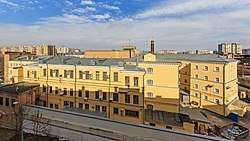Lefortovo District
| Lefortovo District | |
|---|---|
 Location of Lefortovo District on the map of Moscow | |
| Coordinates: 55°45′54″N 37°41′29″E / 55.76500°N 37.69139°ECoordinates: 55°45′54″N 37°41′29″E / 55.76500°N 37.69139°E | |
 Lefortovo Prison | |
.png) |
.png) |
|
| |
| Location | |
| Country | Russia |
| Federal subject | Moscow |
| Statistics | |
| Area | 9.15 km2 (3.53 sq mi)[1] |
| Population (2010 est.) | 27,200 inhabitants[1] |
| Density | 2,972.68/km2 (7,699.2/sq mi)[2] |
| Time zone | MSK (UTC+03:00)[3] |
| Official website | |
| Lefortovo District on WikiCommons | |

Lefortovo District (Russian: райо́н Лефо́ртово, IPA: [lʲɪˈfortəvə] (![]()
History
It is named after a close associate of Tsar Peter the Great, Franz Lefort, whose troops were stationed nearby at the German Quarter. Lefortovo is considered to have been founded in 1699. In the 18th century, it was home to Annenhof, Lefortovo Palace, Sloboda Palace, and Catherine Palace. In later centuries, the district hosted troops and military organizations, and also became heavily industrialized.
The present-day Lefortovo is famous for the Lefortovo Prison, Lefortovo park and the Lefortovo Tunnel on the Third Ring. Several higher educational institutions are located in Lefortovo, such as the Moscow Power Engineering Institute.
See also
References
- 1 2 3 "General Information" (in Russian). Lefortovo District. Retrieved March 27, 2018.
- ↑ The value of density was calculated automatically by dividing the 2010 population estimate by the area specified in the infobox. Please note that this value is only approximate as the area specified in the infobox does not necessarily correspond to the area of the entity proper or is reported for the same year as the population.
- ↑ Правительство Российской Федерации. Федеральный закон №107-ФЗ от 3 июня 2011 г. «Об исчислении времени», в ред. Федерального закона №271-ФЗ от 03 июля 2016 г. «О внесении изменений в Федеральный закон "Об исчислении времени"». Вступил в силу по истечении шестидесяти дней после дня официального опубликования (6 августа 2011 г.). Опубликован: "Российская газета", №120, 6 июня 2011 г. (Government of the Russian Federation. Federal Law #107-FZ of June 31, 2011 On Calculating Time, as amended by the Federal Law #271-FZ of July 03, 2016 On Amending Federal Law "On Calculating Time". Effective as of after sixty days following the day of the official publication.).
- ↑ Russian Federal State Statistics Service (2011). "Всероссийская перепись населения 2010 года. Том 1" [2010 All-Russian Population Census, vol. 1]. Всероссийская перепись населения 2010 года (2010 All-Russia Population Census) (in Russian). Federal State Statistics Service. Retrieved June 29, 2012.
- ↑ Russian Federal State Statistics Service (May 21, 2004). "Численность населения России, субъектов Российской Федерации в составе федеральных округов, районов, городских поселений, сельских населённых пунктов – районных центров и сельских населённых пунктов с населением 3 тысячи и более человек" [Population of Russia, Its Federal Districts, Federal Subjects, Districts, Urban Localities, Rural Localities—Administrative Centers, and Rural Localities with Population of Over 3,000] (XLS). Всероссийская перепись населения 2002 года [All-Russia Population Census of 2002] (in Russian). Retrieved August 9, 2014.
